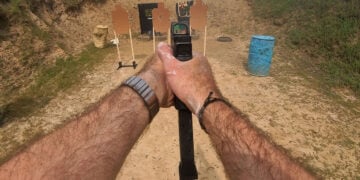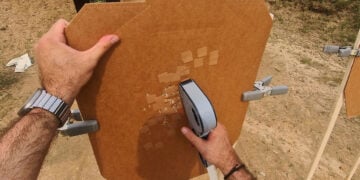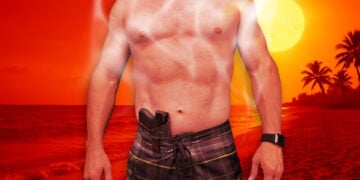Strong-side carry has hardly been abandoned, as many concealed carriers, and certainly the bulk of competitive shooters, use it. However, the increased popularity of Appendix-Inside-the-Waistband Carry over the past decade or so has ushered in a direct competitor to strong-side carry.
This author switched to appendix carry years ago and has not looked back. The benefits of concealment, speed of deployment, and accessibility simply outweigh the usefulness of strong-side carry for this particular individual. And, like so many things, such decisions are, indeed, individual. While now a devotee to appendix carry, I do, nevertheless, have many, many years of strong-side carry experience.
If you are new to concealed carry, in particular, and you are trying to formulate your carry method, you are likely looking at the different carry modes and positions in an effort to determine what works best for you. While I have written extensively about the merits of appendix carry, that in no way disparages strong-side carry. Here, I wish to address not the limitations but the advantages that strong side does, in fact, offer.
When we refer to strong-side carry, we are talking about the positioning of the gun on the side of the hip, accessible to the dominant hand. For right-handed shooters, this usually puts the gun between two and four o’clock on the body circumference. Further to the front of the hips, we move to the appendix position. The placement of the gun slightly behind the hip is also considered strong-side carry.
Compared to appendix carry, the commonly cited downside to strong-side carry is most often the following: First, the gun is usually more challenging to conceal on the side of the body than when in front of the hips. Second, the draw of a concealed gun in front of the hips is usually faster. Third, the gun is more detectable upon incidental contact, such as a hug or bump, than is a gun in the appendix position. Fourth, a strong-side gun tends to be more difficult to access while seated than an appendix-worn gun.
For the most part, the referenced limitations of strong-side carry hold true. However, the strong side offers certain advantages compared to other modes, particularly appendix carry. Let’s look at the advantages, and there are several to consider:
Comfort
Okay, many appendix carriers will gnash their teeth and rent their garments at this point, declaring that they need the right holster if they don’t find appendix carry comfortable. Calm down, street warriors. I wear a gun in the appendix position most of my waking hours. I use the best holsters, and I find them comfortable. Please spare me the lecture. However, you cannot tell me with a straight face that appendix carry is particularly comfortable when doing manual labor that involves bending forward or other vigorous activities. When in the field or working hard, strong-side hip carry is more comfortable, period.
If deep concealment is of no concern, strong-side hip also offers the option to wear an outside-the-waistband holster rather than an inside-the-waistband. This is always a more comfortable affair. When in the field doing vigorous activity, such as working, hiking, or hunting, etc., a strong side belt holster concealed under a jacket or flannel shirt may prove a far better solution than an appendix holster. Depending on your lifestyle, this may be important.
Dress Accommodation
Appendix position carry works very well for many concealed carriers in our contemporary society because dressing with an untucked shirt has become the standard casual mode of dress. A pistol in a good holster, worn in front of the hips, can really disappear under a looser-fitting closed-front shirt. However, this is, indeed, a casual form of dress. When it is necessary to wear formal attire, the appendix position gun must be worn under a tucked-in shirt, making the gun draw more difficult.
People in professions or lifestyles that see them in a suit jacket all the time may find strong-side carry ideal. Notice that most law enforcement, even those in a suit rather than uniform, tend to carry strong-side. Also, If you live in a climate where you are dressed in heavy clothing most of the year, consider how clothing affects your carry mode choice. Appendix carry may not work well if you are wearing multiple layers often. The same may apply to strong-side, but strong-side may be your best option if you dress with tucked shirts covered with a jacket.
Compatibility with Duty Carry
Obviously, most concealed carriers don’t wear a uniform or serve in a law enforcement or military capacity, but some certainly do. Almost all forms of law enforcement carry guns strong-side, especially if in uniform. Even among agents that wear business attire, the gun is most often carried strong-side, under a jacket. If you work in such a profession, it is a compelling argument to stick with the carry mode you already use during working hours. Familiarizing body location is integral to gaining proficiency with drawing the gun, so sticking with strong-side carry for concealment may make good sense.
While appendix carry is certainly not new, there is, indeed, renewed interest in it, and many concealed carriers have moved to that mode of carry. There are many who also stick to the more traditional strong-side, and both modes offer significant advantages and disadvantages. Each individual must make the choice with thoughtful consideration and focused experimentation.









